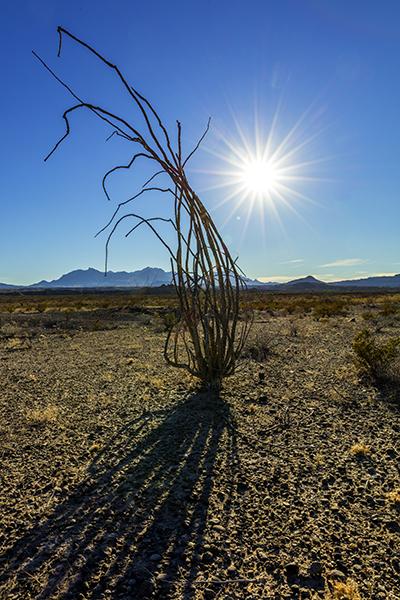
Winter's starkness in Big Bend National Park / Rebecca Latson
Happy New Year, fellow Travelers! A new year is always time for reflection on the past as well as anticipation of a future full of fresh national park photo ops. I’m definitely looking forward to 2017, during which time I plan to visit national parks in Montana, Hawaii, Washington State, and possibly, California.
For this first Photography in the National Parks article of 2017, I’d like to share with you my favorite images captured during 2016 while traveling within Big Bend National Park, Banff National Park, Jasper National Park, and Mount Rainier National Park. You see, I review my past photos not only to refresh wonderful memories of my national park visits, but to understand the photo’s composition, the settings used, and why I just plain like the image. These reasons are certainly helpful to my ongoing photography and they might be helpful to yours, as well. Below are 10 images, listed in no particular order, which I consider to be my favorites from 2016. I present them for your review with the caveat that photography is a subjective art. It’s like looking at the entries of a photo contest while puzzling out why that particular winner was chosen (grin).
- Winters starkness, Big Bend National Park – The image at the beginning of this article speaks to me of “desert bleakness,” and that’s exactly what I wished to portray. I traveled to this national park during mid-January to attend the annual Dark Skies Dinner. Big Bend is a quiet, lonely place during that time of year. I was at the fossil exhibit, searching for something to photograph when my eyes lit upon this ocotillo plant, tall and drop-shaped and bare, as the early-afternoon sun beat down upon the landscape. Squatting low to the ground, I captured the entire thorny plant as a vertical, including the ocotillo’s shadow as a diagonal leading to the lower left corner of the composition. I wanted to create a leading line to the ocotillo while emphasizing the thorny plant’s height. I handheld this shot and utilized both a circular polarizing filter and a lens hood to minimize glare spots and overexposure of the highlights (the sun and bright sky). I also thought it might be neat to experiment a little with this piece and set my aperture to f22 to achieve a sunstar.
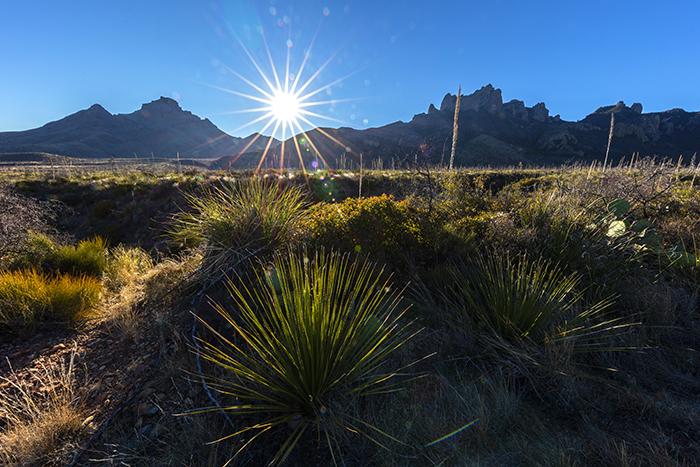
Winter morning in Big Bend National Park / Rebecca Latson
- Winter morning, Big Bend National Park – This was another sunstar image captured in the early morning rather than the mid afternoon during my January visit. The spiny-leaved sotol plant anchored the foreground, the desert behind the sotol provided the midground landscape, and the sun and mountains finished out the background. I opted to create another sunstar effect to emulate the shape of the sotol leaves. The real trick was whether or not I could control the lens flare I knew I’d get from shooting into the sun. I didn’t want to affix a lens hood because I was utilizing my graduated neutral density filter (grad ND) to keep the sky from being totally blown out (overexposed). In retrospect, I’m not even certain a lens hood would have really worked since the lens was pointed directly at the sun. Ultimately, I decided I liked the lens flare and felt it added character to the shot.

Mount Temple sunrise reflection, Lake Louise, Banff National Park / Rebecca Latson
- Mount Temple sunrise reflection, Lake Louise, Banff National Park, Alberta, Canada – Early April is not the best time to visit Banff National Park if you want to hike without snowshoes. The white stuff is still deep, and many of the trails and back roads remain closed to the public. Any melting snow contributes to slick surfaces. I am not the most sure-footed creature at the best of times, and as a result, I contented myself with capturing numerous sunrise, early-morning, and late-afternoon shots of this beautiful Lake Louise landscape, since it was easiest for me to access. In this image, the golden sun was just beginning to bathe the tip of Mount Temple while the rest of the scene was shaded and saturated with brown and green hues. This one area of the lake was the only place free of ice, and I managed to get a nice reflection in the mirror-still water. The boathouse added a sense of scale and rustic “outdoorsy” architecture to the composition. A grad ND filter prevented sky blowout and allowed me to expose for the still-shaded landscape.

Vermilion Lake reflection, Banff National Park / Rebecca Latson
- Vermilion Lake reflection, Banff National Park, Alberta, Canada – The more I look at this photo, the more I like how I’ve captured the neutral and darker shades of late winter/early spring in the mountains. That’s a hindsight appreciation of this image, though. I originally wanted this composition because of the lovely mountain reflection in the water and the interesting, textured cloud bank acting as a layer separating the mountain from the rest of the sky. I employed a tripod and grad ND filter for this image to prevent total overexposure of the sky while adding texture to the cloud bank. Shade coming from a filter helps reveal any texture or definition hidden within an otherwise bright or very light-colored subject.
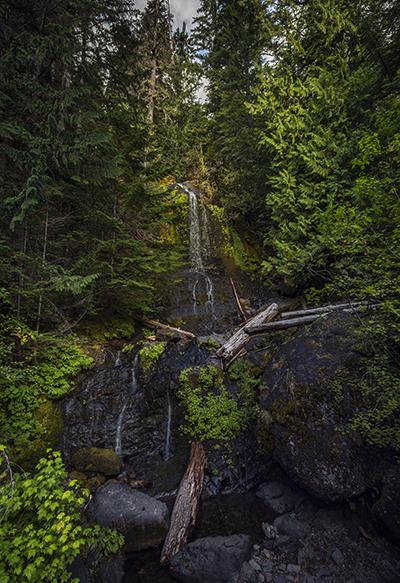
Falls Creek waterfall, Mount Rainier National Park / Rebecca Latson
- Falls Creek waterfall, Mount Rainier National Park – “Luminous” is the word that comes to mind every time I view this photo. In a portion of my November article, I wrote about capturing the luminosity of the forest interior. This image reminds me of that illumination, with the light rock at the falls and brighter leaves and greens surrounded by the cool, darker, shadowed colors of the adjoining wooded area. Although the falls was barely a trickle during the time of my visit, I still wanted some sort of “silky water” shot. My Singh-Ray Vari-ND (“dial-a-shade”) neutral density filter helped me achieve not only smooth water (what little there was) but also emphasized the lighter portions of the composition while keeping the rest of the image shaded.
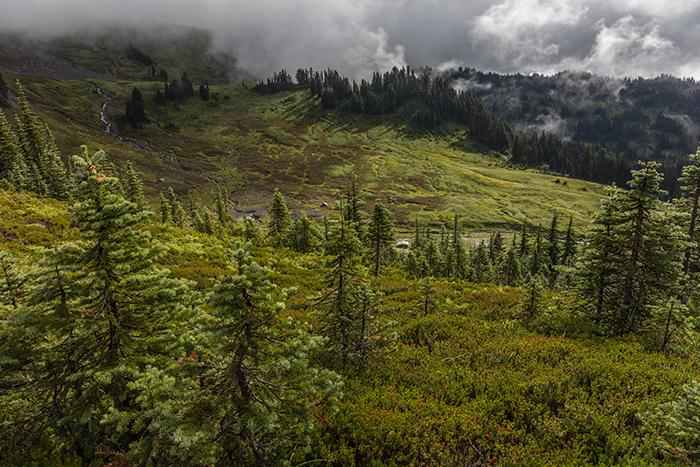
Alta Vista view, Mount Rainier National Park / Rebecca Latson
- Alta Vista view, Mount Rainier National Park – I never managed a view of Mount Rainier in its entirety during my early September visit to the Paradise area, but The Mountain’s absence compelled me to look at the other stunning landscape of which this national park is comprised. I took a much closer look at panoramas such as this one, with its range of light and shadow and green hues on this overcast, misty day. I wanted the conifers in the foreground to lead out to the deep drop of the valley below and the rise of the fog-shrouded forest and Golden Gate Trail beyond. To add texture as well as prevent most of the clouds and fog from overexposure, I used my Lee-brand grad ND filter which I hand-hold flush against the lens.
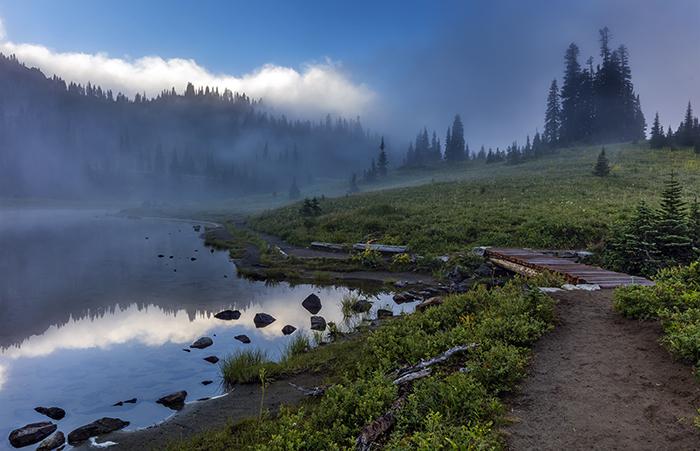
Tipsoo Lake trail, Mount Rainier National Park / Rebecca Latson
- Tipsoo Lake trail, Mount Rainier National Park – The lack of any Mount Rainier gave me pause for reflection of another kind: I focused my attention on this little lake itself rather than continue a fruitless wait for a mountain shrouded behind thick fog. I liked the curving leading line of the path, inviting the viewer to take a walk around the glassine water with the mist wafting over the surface. As with the majority of my images listed in this article, I made use of my grad ND filter (an indispensible accessory that should be found in any photographer's gear bag).
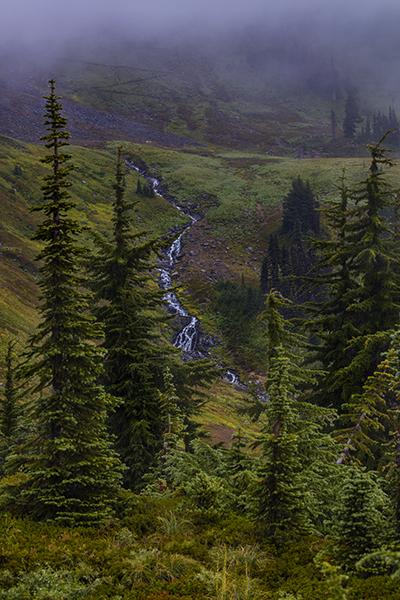
Fog, falls and forest, Mount Rainier National Park / Rebecca Latson
- Fog, falls and forest, Mount Rainier National Park - Green isn’t even my favorite color! Yet, I found my eyes arrested by the many shades of rain- and mist-saturated greens during my stay in this national park. I opted to create a vertical image rather than a horizontal so I could capture the height of the trees and the falls with a little bit of the misty atmosphere which was partially obscuring the zig-zag switchbacks of the trail in the upper portion of the shot. I used a grad ND filter to add texture to the wisps of mist.
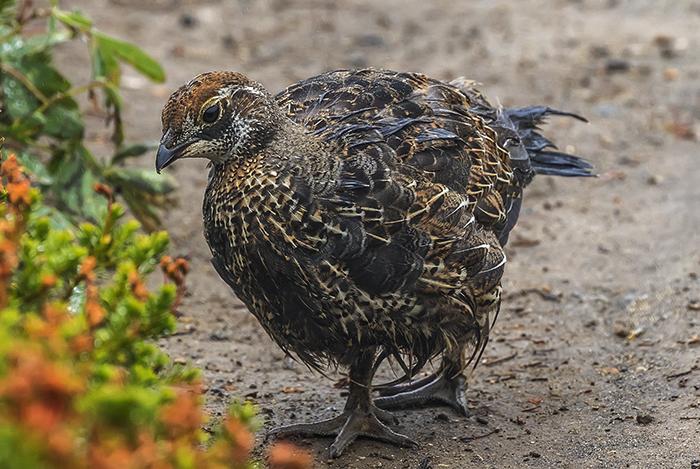
Blue grouse chick on a rainy day, Mount Rainier National Park / Rebecca Latson
- Blue grouse chick on a rainy day, Mount Rainier National Park – Not expecting to experience any wildlife sightings during this time of year in the Paradise area of the park, I was thrilled when this blue grouse chick, its mother, and its sibling popped out onto the trail in front of me. As long as I moved slowly and remained quiet, these birds had no problems with me tagging along. My 100-400mm zoom lens allowed me a closer view of this trio while preventing me from invading their space. The camera’s focus was set to “AI-Servo” so I could get a clear shot of the chick as it moved along, bobbing its head up and down while pecking at the ground.
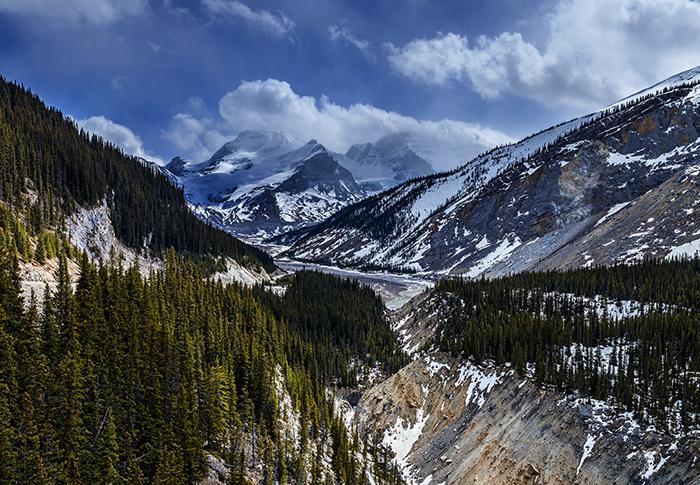
The view from the Glacier Skywalk, Jasper National Park / Rebecca Latson
- The view from the Glacier Skywalk, Jasper National Park - I’ve read that this location was originally a pullout view area rather than the pay-per-view tourist attraction it is now. Even though I forked over some cash to get to this spot, I still thought the skywalk to be a neat experience and was pretty happy to capture a great shot of this amazing scene during my walk on transparency. This is one of those photos I like not only for the stunning scenery, but for the memory it evokes of my experience walking on glass and peering through to the deep canyon directly beneath my feet while feeling a slight frisson of vertigo. I used a circular polarizer on the lens and hand-held the camera, leaning against the glass wall to steady myself.
Those are my 10 faves for 2016. I’m sure you have your own as well, right? I offer essentially the same advice for this new year as I did during a similar article written for the Traveler during a different new year: Figure out why you like a specific image and its composition. National park photos are meant to tell stories, evoke memories, and elicit feelings. If your 2016 favorite images do any or all of the above, then remember why and how you captured that particular photo so you can re-apply those learnings to your 2017 batch of national park imagery. Above all, have fun, and Happy New Year!



Comments
Marvelous images, and interesting stories behind them. Thank you.